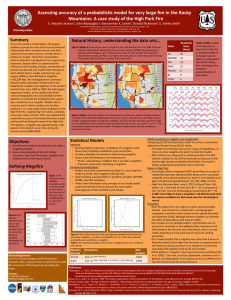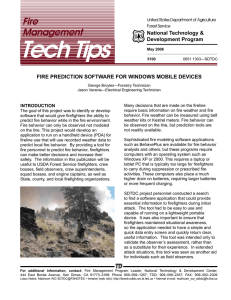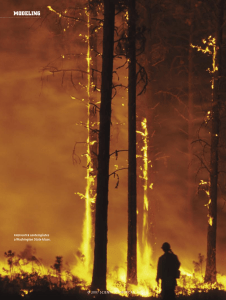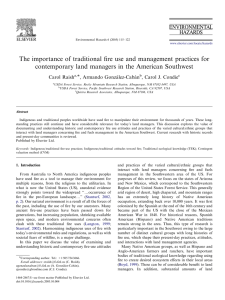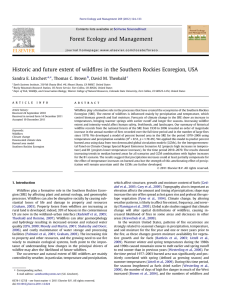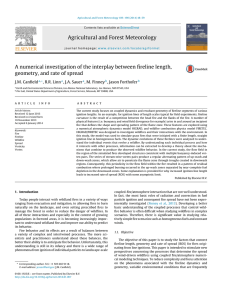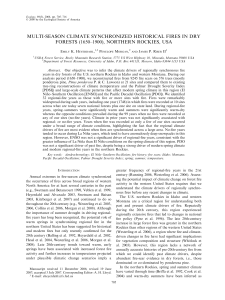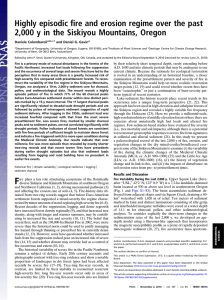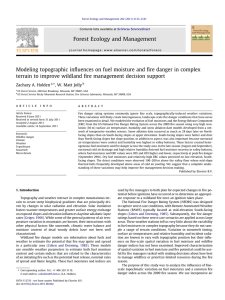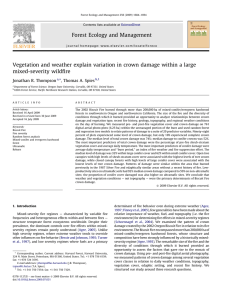F The Technology and Development Program
advertisement
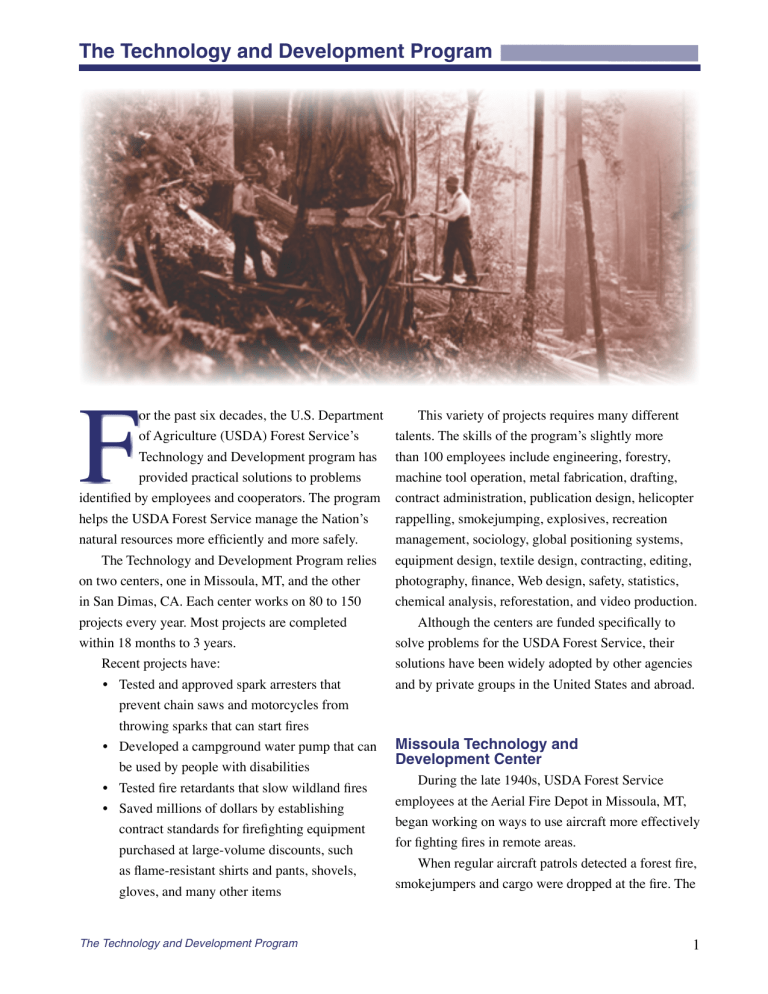
The Technology and Development Program F or the past six decades, the U.S. Department of Agriculture (USDA) Forest Serviceʼs Technology and Development program has provided practical solutions to problems identified by employees and cooperators. The program helps the USDA Forest Service manage the Nationʼs natural resources more efficiently and more safely. The Technology and Development Program relies on two centers, one in Missoula, MT, and the other in San Dimas, CA. Each center works on 80 to 150 projects every year. Most projects are completed within 18 months to 3 years. Recent projects have: • Tested and approved spark arresters that prevent chain saws and motorcycles from throwing sparks that can start fires • Developed a campground water pump that can be used by people with disabilities • Tested fire retardants that slow wildland fires • Saved millions of dollars by establishing contract standards for firefighting equipment purchased at large-volume discounts, such as flame-resistant shirts and pants, shovels, gloves, and many other items The Technology and Development Program This variety of projects requires many different talents. The skills of the programʼs slightly more than 100 employees include engineering, forestry, machine tool operation, metal fabrication, drafting, contract administration, publication design, helicopter rappelling, smokejumping, explosives, recreation management, sociology, global positioning systems, equipment design, textile design, contracting, editing, photography, finance, Web design, safety, statistics, chemical analysis, reforestation, and video production. Although the centers are funded specifically to solve problems for the USDA Forest Service, their solutions have been widely adopted by other agencies and by private groups in the United States and abroad. Missoula Technology and Development Center During the late 1940s, USDA Forest Service employees at the Aerial Fire Depot in Missoula, MT, began working on ways to use aircraft more effectively for fighting fires in remote areas. When regular aircraft patrols detected a forest fire, smokejumpers and cargo were dropped at the fire. The 1 success of these techniques led to the establishment of the Missoula Aerial Equipment Development Center in 1953. Center employees worked in a variety of locations in Missoula before offices were moved to Fort Missoula during the 1960s. Expanding the Centers’ Role The centers soon were solving other nationally important natural resource problems for the USDA Forest Service. In 1987, the names of both centers were changed from “Equipment Development Centers” to “Technology and Development Centers” in recognition of their expanded role. Both centers were scheduled for new facilities San Dimas Technology and during the 1960s. The USDA Forest Service purchased Development Center land near the Missoula airport for the new facility in Also during the 1940s, USDA Forest Service Missoula. employees were consolidating equipment development The Arcadia center moved to its new facility at activities at the Arcadia Fire Equipment Development San Dimas, CA, in 1965, but the Missoula facility was Center in Arcadia, CA. The southern California site not funded. Plans for a new facility were redrafted was selected in 1945 because of frequent fire activity several times, but funding for construction wasnʼt in the area, evolving industrial and academic centers available until 2000. there, and a Forest Service facility the center could In 2002, the Missoula center moved from seven move into. buildings around Missoula to its new facility near the Late in the 1940s, a conference of USDA Forest airport. The new facility includes offices, a chemistry Service range management administrators and laboratory for analyzing fire retardants, a photo studio, researchers recognized that equipment for range a video editing studio, a textile fabrication shop, an seeding and other improvements needed to be adapted electronics shop, a machine shop, and a large meeting or developed. Range became the second “sponsor” room for training. at Arcadia and the centerʼs name was changed to the Arcadia Equipment Development Center. Directors of the Missoula Technology and Development Center Directors of the San Dimas Technology and Development Center Herb Harris ........................................ 1956 to 1969 Ira C. Funk ......................................... 1945 to 1948 Farnum M. Burbank .......................... 1969 to 1974 Eugene E. Silva.................................. 1948 to 1970 Lee Northcutt ..................................... 1975 to 1990 Charles W. Howard ........................... 1970 to 1974 Terry Solberg (Manager) ................... 1990 to 1995 Boone Y. Richardson ............................. 1974-1984 John Steward (Manager) .................... 1995 to 2000 Larry E. Matson .................................... 1984-1986 Dave Aicher (Manager) .................. 2001 to present Leon (Dick) R. Silberberger .............. 1986 to 1997 John D. Fehr (Manager).................. 1997 to present 2 The Technology and Development Program Pictorial History of Technology and Development T he following 12 pages are reduced versions of six panels prepared for a display at the USDA Forest Service Centennial Congress in Washington, DC, during January 2005. The text on the page opposite each panel provides additional information about each group of photographs. The panels show a sampling of work by the Technology and Development Program. Although some of the photos are historic, most of the work is ongoing. Tools for Nurseries Development and Testing of Fire Engines 1950s Improved Logging Systems Clean Slash Burning Aerial Ignition Smokejumping Equipment 2002 Tools To Limit Invasive Species 1970s Development and Testing of Fire Shelters Tools for Healthy Forests Evaluation and Testing of Wildland Fire Chemicals Trail Maintenance Traditional Tools Chaps for Chain Saw Safety Tools To Reduce Road Impacts Accessibility Employee Health and Safety Hardhats Shirts Gloves Pants Water/Road Tools Spark Arrester Testing Employee Safety Videos Facility Improvements The Technology and Development Program Personal Protective Equipment Training Guides 3 Development and Testing of Fire Engines Development and Testing of Fire Shelters Testing during the 1950s led to development of the fire shelter carried by wildland firefighters since the 1970s. All but one of the designs in the 1950s photo have a flaw: the firefighter is standing up. Assuming that firefighters clear an area of fuel, temperatures at the surface of the ground will be much lower than temperatures even 1 foot above the ground when a fire passes over. The Technology and Development Programʼs first projects involved improving firefighting equipment. Fire engines have made a lot of progress from the 1930s (upper left photo in the fire engine collage) to the 1990s (lower right photo, fire engine collage). Todayʼs engines can pump water more quickly, helping firefighters control wildland fires. The San Dimas Technology and Development Center continues to improve fire engines. Development and Testing of Fire Engines 1950s 2002 1970s Development and Testing of Fire Shelters The fire shelter has saved the lives of more than 300 firefighters and has prevented many more injuries. The Technology and Development Program developed a new version of the fire shelter at the turn of the 21st century after laboratory and field testing. The new fire shelter, completed in 2002, provides additional protection, although no shelter can protect firefighters from all conditions. The use of a fire shelter is considered a wildland firefighterʼs last resort. 4 The Technology and Development Program

